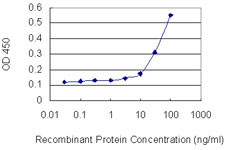Search Thermo Fisher Scientific
Product Details
H00002706-M01
Species Reactivity
Host/Isotype
Class
Type
Clone
Immunogen
Conjugate
Form
Concentration
Purification
Storage buffer
Contains
Storage conditions
Shipping conditions
Product Specific Information
Sequence of this protein is as follows: MDWGTLQTIL GGVNKHSTSI GKIWLTVLFI FRIMILVVAA KEVWGDEQAD FVCNTLQPGC KNVCYDHYFP ISHIRLWALQ LIFVSTPALL VAMHVAYRRH EKKRKFIKGE IKSEFKDIEE IKTQKVRIEG SLWWTYTSSI FFRVIFEAAF MYVFYVMYDG FSMQRLVKCN AWPCPNTVDC FVSRPTEKTV FTVFMIAVSG ICILLNVTEL CYLLIRYCSG KSKKPV
Target Information
Gap junctions are conduits that allow the direct cell-to-cell passage of small cytoplasmic molecules, including ions, metabolic intermediates, and second messengers, and thereby mediate intercellular metabolic and electrical communication. Gap junction channels consist of connexin protein subunits, which are encoded by a multigene family. GJBs (gap-junction proteins or connexins) play crucial functional roles associated with these channels. Defects in GJB3 have been linked to erythrokeratodermia variables (EKV) is an autosomal dominant genodermatosis characterized by transient figurate red patches or hyperkeratosis. Mutations in GJB2 have also been associated with genetically derived hearing impairments, including autosomal recessive nonsyndromic deafness.
For Research Use Only. Not for use in diagnostic procedures. Not for resale without express authorization.
References (0)
Bioinformatics
Protein Aliases: connexin 26; Connexin-26; Cx26; Gap junction beta-2 protein; gap junction protein, beta 2, 26kDa; mutant gap junction protein beta 2
Gene Aliases: CX26; DFNA3; DFNA3A; DFNB1; DFNB1A; GJB2; HID; KID; NSRD1; PPK
UniProt ID: (Human) P29033
Entrez Gene ID: (Human) 2706

Performance Guarantee
If an Invitrogen™ antibody doesn't perform as described on our website or datasheet,we'll replace the product at no cost to you, or provide you with a credit for a future purchase.*
Learn more
We're here to help
Get expert recommendations for common problems or connect directly with an on staff expert for technical assistance related to applications, equipment and general product use.
Contact tech support

